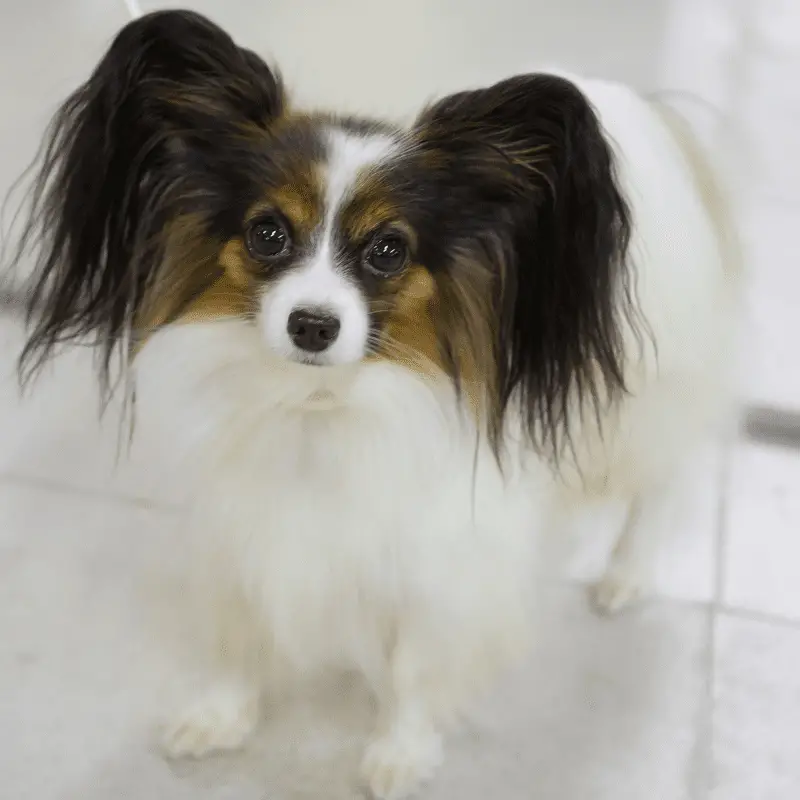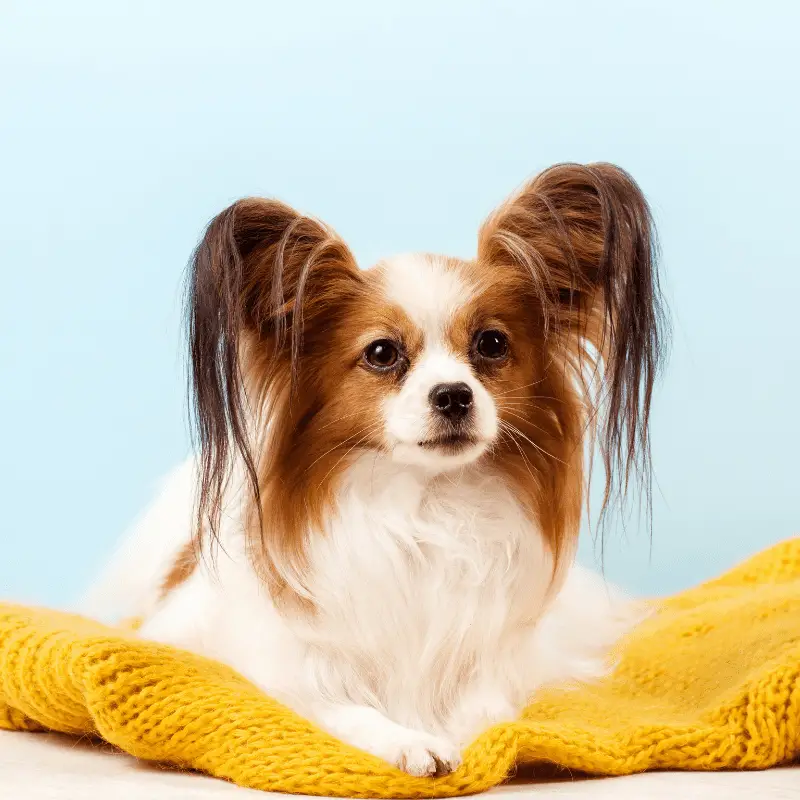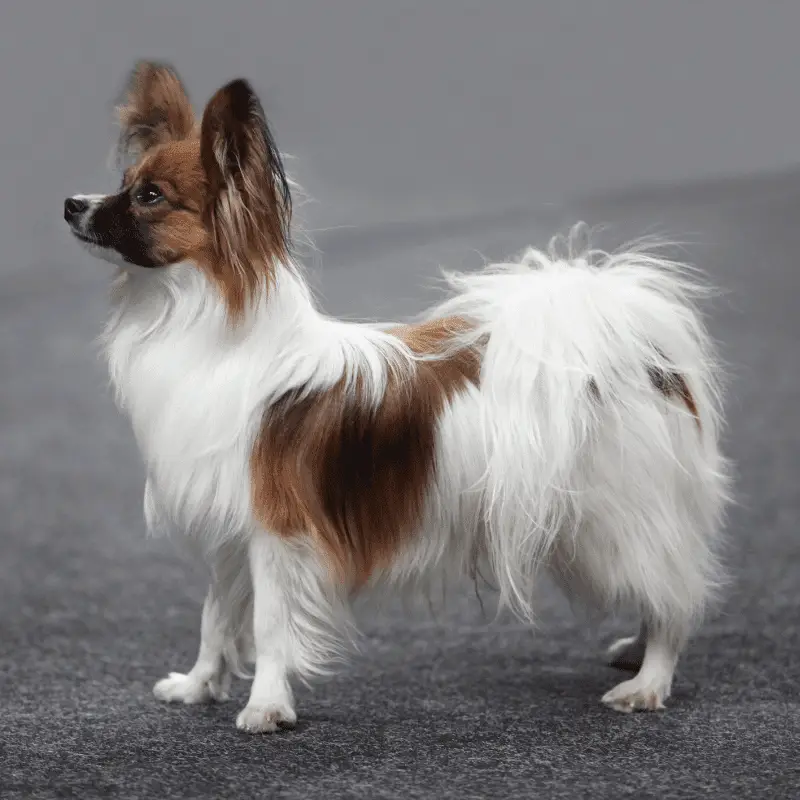The name of the Papillon dog breed came from the French word papillon that stands for butterfly. This word denotes the strong resemblance of the erect and widely set angled ears with a flying butterfly. The thin white blaze of line that bisects the face of these dogs into two halves makes the resemblance even more pronounced.
Most people consider Papillons as complete lap dogs, but they are wrong. While these dogs love to stay close to their human companions, they crave continuous mental and physical stimulation. You have to give them adequate exercise to keep them happy and healthy.
Other than the strong resemblance with butterflies, the Papillons are one of the cutest toy breed dogs with a lot of energy and spunk. Their joyous and playful nature and an innate desire to please their human companions make the Papillons so famous among the owners.
Of course, Papillon owners love the fancy resemblance to the butterfly, but they love the keen intelligence of these dogs even more. Many owners worldwide value the Papillon dog breed for their intelligence or obedience and deep-rooted and colourful history.
In this article, we would be highlighting the colourful journey that these dogs have experienced over centuries. We will also see how these dogs slowly changed over time and how they gained the recognition they are enjoyed today. But before we do that, let’s find out the identifying features of the Papillon dogs in the first place.
Identifying the Papillon Breed
The Papillons are one of the most intelligent and cute dogs in the world. It is one of the oldest European dog breeds that are still popular today. The butterfly-like ears are the most striking feature of the Papillon dogs.

However, not all Papillon possess that angular and broad ear structure. There is another variety of Papillon, known as Phalene. The dogs belonging to this variety have dropped-down ears. Other than that, every physical aspect of this dog is similar to the Papillons. Phalene is also a French term, which means moth, another winged beauty that does not keep its wings open while perching.
The funny fact is that Phalene and the Papillons can be born in the same litter. While both these dogs are cute as buttons, the Phalene dogs are not as popular as their siblings with upright ears.

Considered a toy breed, the Papillon can gain a maximum of 28 cm in height when fully grown. An adult Papillon dog weighs between 7 to 10 lb. Their tail is long and fluffy, creating a plume over their backs. Even though these dogs have fluffy hair, they don’t shed much this is because they do not have double coats, like many other dog breeds. While these dogs can handle the heat pretty well, they can’t control the bitterly cold temperature.
Now that we have a clear idea about the identifying features of the Papillons let’s check out the breed’s detailed and colourful history.
History Timeline
As we have discussed earlier, Papillon is one of the oldest breeds. It is one of the oldest European breeds that are still popular even today. The canine experts think that the Papillon breed is about 700 to 800 years old. The age of the breed was roughly calculated depending on the oil paintings from the 12th century.
Those paintings depict pictures of dogs that had very similar features to the Papillons of today. It is challenging to draw any conclusion about whether those painted dogs were the ancestors of Papillons of today. However, the Papillon dog breed was created when keeping written records about dog breeds was not expected. Thus, all the history that we know about the ancestors of the Papillons today is mostly speculation.
13th Century
Images of small dogs with a strong resemblance to the Papillons of today was found in many paintings of this period. At that time, the name of the small dog breed was Epagneul Nain Continental or Continental toy Spaniel.
From this, it can be assumed that the Papillon dogs were traditionally considered a type of Spaniel. However, modern experts have pointed out that the Papillon might not belong to the spaniel breed. Spaniels are one of the oldest European dog breeds.
The drooping ears and long feathery coat had to give these dogs an exceptional look. Spaniels were bred as hunting dogs. These dogs were primarily used for bird hunting. While Spaniels were bred as gun dogs, many breeds of the specific family predate the guns. Experts have concluded that the Papillon breed is a descendant of the Spitz dog breeds.
The word spaniel developed from a French term that means the dogs for the Spaniards. While this makes many people assume that the spaniels were created in modern Spain, it can mean that the dogs were bred in Hispania, a Roman province.
Spaniels were trendy Across the Western European region. During this time, they created several very small spaniels that were bred for companionship primarily.
Much like the spaniel group, it is also very confusing when, where, and how the toy spaniels were first developed. The earliest depiction of the toy spaniels that we see in the paintings of the Old Masters is around the twelfth century.
The earliest paintings of the toy spaniels were found in an Italian painting belonging to the late 12th century. That is why people assume that toy spaniels were first bred in Italy. It is also thought that toy spaniels, like the Papillon dog breed, might of been created by mixing larger spaniels with Italian greyhounds, Maltese, and other small companion dogs.
1500’s
Mini paintings of Italian merchants and nobilities from this time possessed toy spaniels resembling the Papillons. In the early 1500s, one of the well-known Italian painters, Titian, printed a toy spaniel that looked significantly different. These spaniels were, mostly, white with patches of red on their head and bodies. This type of toy spaniel had significant similarities with the Phalene dogs of today. These dogs are considered the original ancestors of today’s Papillon.
However, historically, these dogs are known as the Titian spaniels. The speculation of the ancestry of the Titian spaniels leads to the toy dogs of Greece and Rome. These toy dogs belong to a spitz-type which had since been extinct. During the Dark Ages, the working and hunting dogs were owned by the owners. However, at the beginning of the Renaissance, Italy became one of the primary sources of toy breeds of many types. During this time, toy Greyhound dogs of Cayenne dwarf barbets and several other breeds pop up. It is assumed that these breeds are created by crossing various sorts of dog breeds. The toy spaniel that Titian painted in his oil paintings was different from all others.
Most experts of the modern-day have made observations about the purpose of the toy spaniels. They have pointed out that these dogs had no other purpose but to fulfil the rich and powerful fancies of that time.
However, Papillon dogs used to serve their masters in some other ways. These small spaniels were also used as lapdogs to keep their masters warm. It was an essential task of them in an age full of drafty Manors and castles. The ancient physicians believed that small spaniels come with various healing properties. They often prescribed spaniel comforters or gentles to cure a range of disorders.
The 1600s and 1700s
The popularity of the toy Spaniel increased during this time, and it started to spread all over Europe. By the time of the reign of Louis XIV, the breeders had been able to create a dog breed that looked almost similar to modern Phalene. Most of the credit for that goes to the French breeders.
King Louis XV and Marie Antoinette had Phalene-like dogs as their pets. Marie Antoinette walked to the guillotine along with her Papillon dog’s and was put to death. The dogs were then cared for by the house inhabitants she once lived. The house is today is known as The House of Papillon.
Until the French revolution, the Papillon dogs mainly were restricted to the courts of the royals, the households of the nobles and wealthy merchants.
The 1800s
The erect eared Papillons appeared during this period and were immensely popular among the owners. It was never proven whether the change in appearance happened due to mutation or some other reason. However, the experts are sure that it did not appear due to the cross-breeding process.
1902
Both the varieties, the Papillons and Phalene, were accepted in the Belgian dog shows in 1902. That is where the name Papillon stuck to the erected eared toy dog breed. Throughout the continent, the dogs with dropped-down ears were known as the continental dwarf spaniels. It was around 1955 that the name Phalene was finally approved for these dogs.
1930
The Papillon Club of America was formed.
1935
American Kennel Club gave the Papillion dog breed full recognition as a toy breed. The AKC has since treated the Phalene and the Papillon dogs as a single breed, the Papillon.
1965
The Papillon Club of Sweden was established to develop this dog breed.
Popularity
The popularity of the Papillon dog breed keeps on growing for the last several decades. Along with America, the Papillon dogs have made space for themselves in many countries across the world. Even though it has not yet achieved America’s most popular breed, they have secured 35th place among 167 various breeds in America. The experts assume that the popularity of the Papillon will keep growing in the future.











